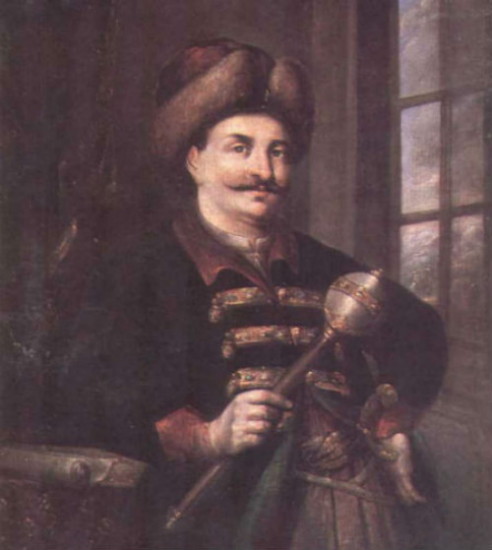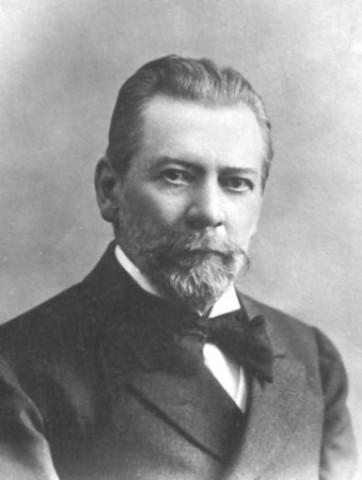Khanenko
Khanenko [Ханенко; Xanenko]. Cossack starshyna family established by Stepan Khanenko, who at the beginning of the 17th century joined the Zaporozhian Sich. Prominent political leaders of the Hetman state and important cultural figures of the 19th–20th centuries came from this family. In the late 1650s Mykhailo Khanenko, Stepan's son, attained the office of colonel of Uman regiment, and later became hetman of Right-Bank Ukraine (1669–74) and Petro Doroshenko's opponent. One of Stepan's grandsons, Fedir (d 1744), became quartermaster of Kyiv regiment, while another, Danylo, became acting colonel of Lubny regiment and took part in a joint Russian campaign against the Tatars; he perished at the siege of Kazi-Kerman in 1697. Danylo married the daughter of General Quartermaster Ivan Lomykovsky. Mykola Khanenko (1693–1760), Danylo's son, was a prominent political and diplomatic figure of the Hetman state. Among his sons the most successful was Vasyl (ca 1730–?), who studied in Hlukhiv, Saint Petersburg, and Kiel, and served from 1752 to 1762 as cavalry captain of the Holstein Corps in Saint Petersburg and abroad, and as personal adjutant of Tsar Peter III. In 1762 he resigned his military commission and settled in Lotaky village in Starodub regiment on an estate granted to him by Hetman Kyrylo Rozumovsky. He was one of the largest landowners of the Hetman state. Vasyl's younger brother, Ivan (1743–ca 1797), after studying in Saint Petersburg, was appointed fellow of the standard in 1767 and fought in the Russo-Turkish War of 1768–74. Later he served as Count Petr Rumiantsev's personal adjutant. In 1783, having retired from military service, he was marshal of the nobility for Pohar county. His extensive landholdings consisted of villages in Pohar and Starodub counties. Towards the end of his life he resumed military office as lieutenant-colonel of the Hlukhiv Rifle Regiment. His wife, Sofiia Horlenko, was the great-granddaughter of Hetman Danylo Apostol. Ivan's older son, Oleksander (ca 1776–1830), served under the patronage of the chancellor, Prince Oleksander Bezborodko, as a court councilor at the Collegium of Foreign Affairs from 1799. In 1800 he was appointed secretary to the Russian legation in London. Eventually, he retired to his estate in Surazh county and was elected marshal of the county nobility. He also belonged to a Ukrainian autonomist circle. Ivan's grandson, Mykhailo (1818–52), served in the 1840s as marshal of the nobility of Novhorod-Siverskyi county, and was interested in Ukrainian history. He wrote articles on the economy of the northern Chernihiv region. Mykhailo's brother Oleksander Khanenko (ca 1816–95) wrote a number of historical studies. A third brother, Ivan (1817–91), published materials on Surazh county. The son of Ivan Ivanovych, Bohdan Khanenko (1848–1917), was a noted art collector, archeologist, and art patron.
BIBLIOGRAPHY
Bodianskii, O. ‘Istoricheskoe svedenie o general’nom khorunzhem Nikolae Daniloviche Khanenke,’ Chteniia v Imperatorskom obshchestve istorii i drevnostei rossiiskikh, 1 (1858)
Lazarevskii, A. ‘Predislovie k Dnevniku Nikolaia Khanenko,’ KS, no. 3 (1884)
Titov, A. ‘Dnevnik Nikolaia Khanenko,’ KS, nos 7–8 (1896)
Modzalevskii, V. Malorossiiskii rodoslovnik, vols 1–4 (1908–14)
Ohloblyn, O. Khanenky. Storinka z istoriï ukraïns’koho avtonomizmu 18 st. (Kiel 1949)– ‘Khanenky,’ Liudy staroï Ukraïny (Munich 1959)
Arkadii Zhukovsky
[This article originally appeared in the Encyclopedia of Ukraine, vol. 2 (1988).]


.jpg)